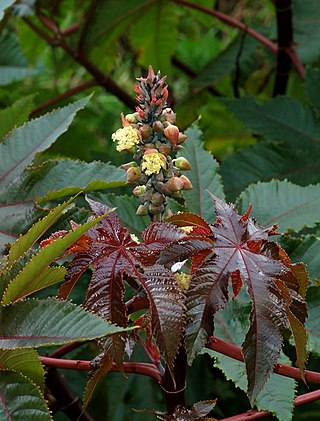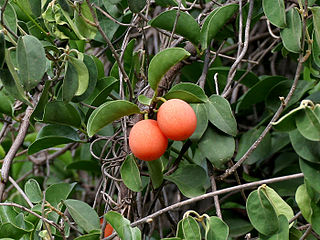
Ricinus communis, the castor bean or castor oil plant, is a species of perennial flowering plant in the spurge family, Euphorbiaceae. It is the sole species in the monotypic genus, Ricinus, and subtribe, Ricininae. The evolution of castor and its relation to other species are currently being studied using modern genetic tools. It reproduces with a mixed pollination system which favors selfing by geitonogamy but at the same time can be an out-crosser by anemophily or entomophily.

Gypsophila is a genus of flowering plants in the carnation family, Caryophyllaceae. They are native to Eurasia, Africa, Australia, and the Pacific Islands. Turkey has a particularly high diversity of Gypsophila taxa, with about 35 endemic species. Some Gypsophila are introduced species in other regions.

Malpighiaceae is a family of flowering plants in the order Malpighiales. It comprises about 73 genera and 1315 species, all of which are native to the tropics and subtropics. About 80% of the genera and 90% of the species occur in the New World and the rest in the Old World.

Calotropis is a genus of flowering plants in the family Apocynaceae, first described as a genus in 1810. It is native to southern Asia and North Africa.

Peridiscaceae is a family of flowering plants in the order Saxifragales. Four genera comprise this family: Medusandra, Soyauxia, Peridiscus, and Whittonia., with a total of 12 known species. It has a disjunct distribution, with Peridiscus occurring in Venezuela and northern Brazil, Whittonia in Guyana, Medusandra in Cameroon, and Soyauxia in tropical West Africa. Whittonia is possibly extinct, being known from only one specimen collected below Kaieteur Falls in Guyana. In 2006, archeologists attempted to rediscover it, however, it proved unsuccessful.

Andrographis paniculata, commonly known as creat or green chiretta, is an annual herbaceous plant in the family Acanthaceae, native to India and Sri Lanka.

Cussonia is a genus of plants of the family Araliaceae, which is native to the Afrotropics. It originated in Africa and has its center of distribution in South Africa and the Mascarene Islands. Due to their striking habit, they are a conspicuous and easily recognizable group of plants. Their genus name commemorates the botanist Pierre Cusson. The Afro-Malagasy and Asian Schefflera, and Afrotropical Seemannaralia genera are related taxa that share several of its morphological characteristics, among which the leaves borne on the end of branches, inflorescences carried on terminal branches or stems, and reduced leaf complexity in developing inflorescences.

Anogeissus leiocarpa is a tall deciduous tree native to the savannas of tropical Africa.

Ximenia americana, commonly known as tallow wood, hog plum, yellow plum, sea lemon, or pi'ut (Chamorro), is bush-forming shrub/small tree; a species from the Ximenia genus in the Olacaceae family. It is mainly found in the tropics, ranging from Africa, India and southeast Asia, to Australia, New Zealand, Pacific Islands, West Indies, Central, North and South America. It is especially common in Africa and South America. It is not domesticated so it is only found occurring in the wild.

Olea paniculata, commonly known as the native olive, is a plant of the genus Olea and a relative of the olive. It grows natively in Pakistan and southwestern China (Yunnan) through tropical Asia to Australia and the Pacific islands of New Caledonia, Vanuatu and Lord Howe Island.

Podaxis is a genus of secotioid fungi in the family Agaricaceae. Species, which have the appearance of a "stalked-puffball", have a worldwide distribution, and tend to be found growing solitary or scattered on sandy soils, especially in arid regions. Although close to 50 species have been described, it has been argued that many of them may represent extremes in the natural range of variations found in Podaxis pistillaris.

This article lists the largest organisms for various types of life and mostly considers extant species, which found on Earth can be determined according to various aspects of an organism's size, such as: mass, volume, area, length, height, or even genome size. Some organisms group together to form a superorganism, but such are not classed as single large organisms. The Great Barrier Reef is the world's largest structure composed of living entities, stretching 2,000 km (1,200 mi), but contains many organisms of many types of species.

Cissus quadrangularis is a perennial plant of the grape family. It is commonly known as veldt grape, winged treebine or adamant creeper. The species is native to tropical Asia, the Arabian Peninsula and much of Africa.

Caldcluvia is a monotypic genus in the family Cunoniaceae with the only species Caldcluvia paniculata, known as tiaca, an evergreen tree native to Chile. It is found from Ñuble to Aisén. Most species that were previously placed in the genus are now placed in Ackama, Opocunonia and Spiraeopsis.

Aloe buettneri is a species of succulent plant in the family Asphodelaceae. It is found in West Africa and is known for its medicinal uses.
Dodecadenia is a botanical genus of flowering plants in the family Lauraceae. It contains a single species, Dodecadenia grandiflora. It is present from central Asia, to Himalayas and India. It is present in tropical and subtropical montane rainforest, laurel forest, in the weed-tree forests in valleys, mixed forests of coniferous and deciduous broad-leaved trees, Tsuga forests; 2,000–2,600 metres (6,600–8,500 ft) in China in provinces of Sichuan, Xizang, Yunnan, and countries of Bhutan, India, Myanmar, and Nepal.

Clematis paniculata is a species of flowering plant in the buttercup family Ranunculaceae. It is one of seven species of clematis native to New Zealand. C. paniculata is the most common of these, and is widespread in forests throughout the country.

Olearia paniculata, commonly called akiraho, is a species of shrub or tree in the family Asteraceae, found only in New Zealand. The tree can grow to 6 metres high, and has yellow-green, oval-shaped leaves, with white undersides and wavy margins.

Diospyros paniculata, or the panicle-flowered ebony, is a species of tree in the ebony family. Endemic to the Western Ghats area of India and parts of Bangladesh, the species is currently listed as Vulnerable in the IUCN Red List.


















